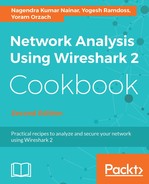The process of auto configuring the IPv6 address is known as Stateless Address Auto Configuration (SLAAC). As we saw earlier, when IPv6 is enabled on any device, a link-local address from the fe80::/10 range is assigned by default. As mandated by the IPv6 address format, the interface ID (last 64 bits) of an IPv6 address must be unique for each host within the network. So how can we assure that the auto configured IPv6 address is unique for each host within the network? In an LAN, the MAC address is a data-link layer identifier assigned to each host and is expected to be unique within the network. This is to ensure that the frame is delivered to the right host. IPv6 auto configuration leverages the uniqueness of the MAC address for IPv6 auto configuration. But there is one challenge – the MAC address is of a 48-bit size while the interface ID is of a 64-bit size. The MAC address comprises a 24-bit Organizational Unique Identifier (OUI) followed by 24-bit Vendor-assigned Identifier. This MAC address is converted to a 64-bit EUI-64 addressing format using the following procedure:
- A 16-bit hex value FFFE is inserted between the OUI and Vendor-assigned identifier
- The U/L flag (bit 7) in the OUI is set to 1
The following is an illustration of the preceding steps:

The resulting 64-bit value is concatenated to the 64-bit network prefix {fe80::/10 + 54 bits all-zero value} to auto configure a 128-bit unique IPv6 link-local address. As the name suggests, this address is link-local scoped and so cannot be used for communicating with nodes outside the LAN network.
IPv6 SLAAC signals a global unique prefix from the router and leverages the end host capability of generating the EUI-64 address to auto configure a globally unique IPv6 address. ICMPv6 plays the role of signaling protocol for the router to advertise the global unique prefix to the end hosts within the LAN network. The following are the two ICMPv6 message types used for this purpose:
- Router solicitation message
- Router advertisement message
Any end host that is enabled with IPv6 auto configuration will send an ICMPv6 router solicitation message. The source address of this ICMPv6 message is normally set to the link-local address of the interface and the destination address is set to an all-router link-local multicast address (ff02::2). The message has the following format:

The router connected to the LAN network will periodically send ICMPv6 router advertisement messages carrying the prefix and other related details that can be used by the end host for address autoconfiguration. The source address of this ICMPv6 message will be set to the link-local address of the router interface and the destination address will be set to all-node link-local multicast address (ff02::1). The message has the following format:

